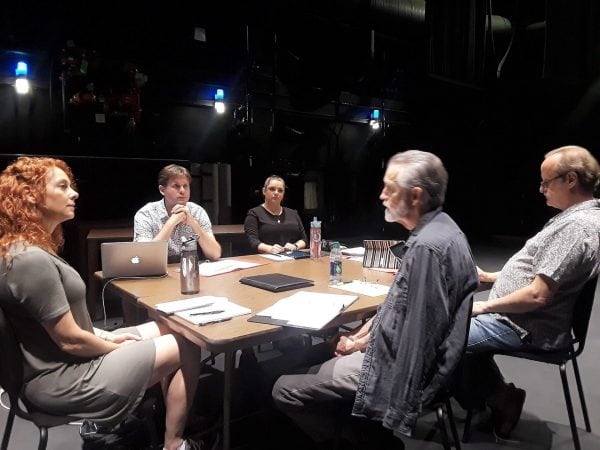
Behind the Scenes of Tampa Rep’s Heisenberg
Delving into why the two-person play feels bigger than it looks.
BY JULIE GARISTO | Sept. 13, 2018
I had the pleasure of reviewing Tampa Repertory Theatre‘s production of Heisenberg at HCC-Ybor this week. It’s the first time the play has been produced in Tampa Bay.
The caliber of performances by Emilia Sargent and Michael Mahoney impressed me beyond my usual admiration of their work. Their portrayal of Georgie and Alex, a reserved, 75-year-old butcher and a wildly extroverted 42-year-old American, conveys an honest intimacy not found in the typical rom-com.

Heisenberg playwright Simon Stephens, the Tony and Olivier Award-winning talent behind The Curious Incident of the Dog in the Night-time has an affinity for fish-out-of-water characters. He once told The Guardian that films such as Blue Velvet and Taxi Driver inspired him to write plays. He said he wanted to be that visceral and has succeeded.
Locally, Jim Sorensen, a versatile actor/director we’re used to seeing on our side of the bay at professional theaters American Stage and freeFall Theatre, directs the actors in Heisenberg and elicits that uncompromising realness Stephens writes so well.
Creative Pinellas asked Sorensen; stars Emilia Sargent and Michael Mahoney; lighting designer Jo Averill-Snell; composer Igor Santos; and set designer Lea Umberger what went into making the seemingly minimal production pure magic.
Jim Sorensen, director

How do you direct a play as intimate as this one?
I had worked with each actor very briefly, and had a lot of respect for their individual talents. And they had both played recently in Tampa Rep’s A View from the Bridge, so were already friendly and excited about taking on this great piece. When we got in the room, it all just clicked. With only two actors and a director, it’s pretty easy for us all to get our thoughts in, and starting from a place of strong mutual respect allows us to dive more deeply into things more quickly.
Tell us about a time where you had to make a change in direction to make the scene work.
As a character, Georgie constantly pushes buttons and searches for chinks in Alex’s armor. To Alex, some of that button-pressing is annoying, some of it is baffling, but much of it is charming. And it’s when Georgie senses that she has charmed Alex that she, consciously or not, takes it to the next level. At the end of Scene 4, she finally pushes him over the edge. Initially, as a scene, we had played this very introspectively, keeping Alex in his “comfort zone” of trying to figure things out from inside his walls, but it was reading as a bit boring. So we pivoted and I pushed the actors both to take the scene to the limits of their emotion — hold nothing back, let it all hang out. It took some finessing, but that’s where we ended up, and I’ve heard feedback saying that’s one of the most intense and satisfying moments of the show.
How do you create that comfort level with the actors?
The first key to success there is to make sure that everyone involved is 100 percent invested, 100 percent respectful, and 100 percent safe. It’s the job of the director to set the tone that we’re all on the same page, that we all have agency and that our opinions are all valid — that’s I think the most important element I brought to the table. … Through questioning, exploration and examination, we were able to come to decisions together about how to proceed, and about the kind of story we wanted to tell. At the end of the day, it’s the actors that will be out there — if I don’t have their buy-in, we’re not going anywhere. I also can’t emphasize enough that, even before we started, we all three (Michael, Emilia and I) belonged to a mutual admiration society — I knew and respected their work and vice versa. It’s a little easier than trying to create comfort with a mortal enemy.
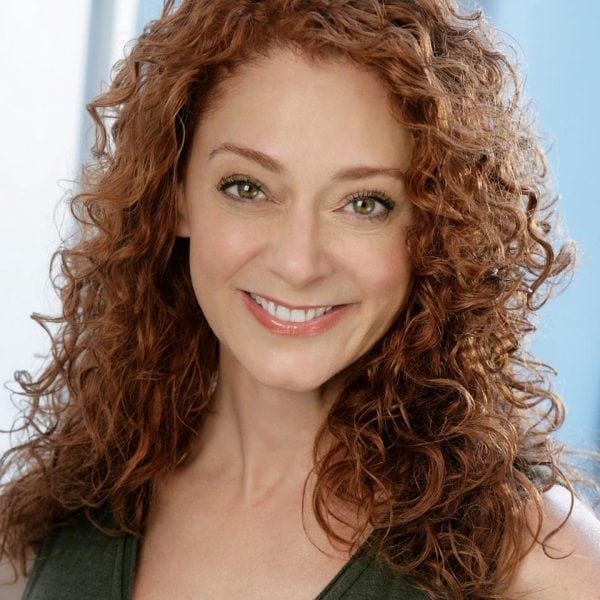
Emilia Sargent, actor (Georgie Burns)
How does Jim, as a director, help you refine your performance?
Jim came into Heisenberg with a clear vision, which made the entire process smooth and allowed actors and designers to create confidently toward that vision. He clearly loves actors, being an accomplished one himself, and gave us rein and encouraged us to play and form throughout the rehearsal process. As an actor, it is of utmost importance to me that I leave no stone unturned and have the freedom to explore and become in order to bring my best forward for the audience. From the start, I trusted that Jim would have my back and help me to accomplish that with Georgie. He has a keen eye, attention to detail while holding to a larger vision, an aversion to cliche, and a sense of play that brings exciting, tremendously fun, and unexpected turns to the work. With his passion, preparedness, and collaborative spirit, Jim is a fabulous director to work with.
The character of Georgie is over the top at times but we like her. What did you need to do as an actor to feel comfortable in her shoes?
There is always a facet of yourself that is similar to the character. In this case, I share Georgie’s supercharged energy, love for fun, being a parent, and her interest in science, to name a few things. Of course, her need to engage and find her way is universally human. In a way, Georgie lets my over the top “muchiness” out to play! I believe it’s important to fall in love with your character, flaws and all. Finding a way to resonate with those flaws and humanity is part of why I love what I do. Connecting viscerally to the character’s honest intentions and they how they align with the character’s actions comes from searching deeply for understanding and answering the question, “what are her actions like for me?” This develops extreme empathy and I fall in love. Somewhere along the way, the magic happens and it becomes easy. When paired with an equally passionate, thoughtful actor, such as Michael Mahoney, it’s truly an enchanting experience. Georgie is one I will never forget.
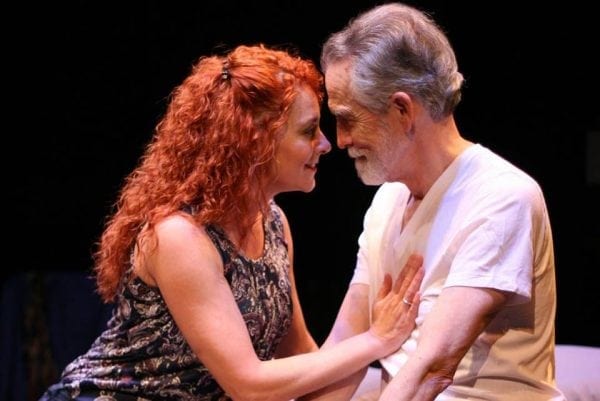
Michael Mahoney, actor (Alex Priest)
Like the character of Alex, the play has a rich inner life. Its depth and complexity become apparent in the process of study and rehearsal. And it just continues to unfold and grow from night to night in performance.
Some weeks before rehearsals began, Tampa Rep’s Artistic Director, David Frankel provided a personal spark by pointing out that Alex is a kind of “Sleeping Beauty” who is awakened by Georgie’s kiss on the back of his neck – an insight that has stayed with me ever since.
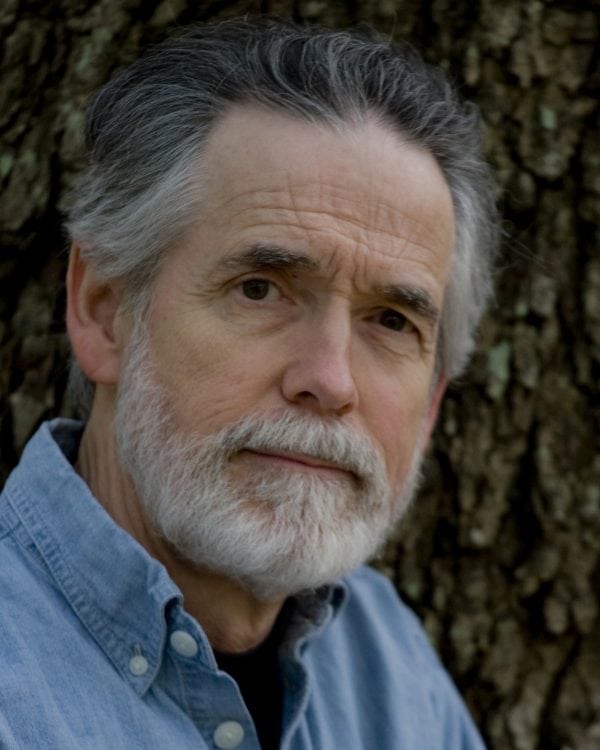
Our director, Jim Sorensen, was the very embodiment of “spark” – bright, energetic and fearless, with great instincts and a talent for clear communication. A superb actor himself, he did what the best directors always do, but with a deep understanding of how actors work and what their needs are. The work was intense, but Jim was always supportive and encouraging, even when I needed a course correction. He was particularly adept at pointing out this actor’s bad habits.
And the last, and in some ways the most important spark came from Emilia Sargent – or perhaps I should say it appeared in the space between us. This was our first time working together (one on one), and I think we both felt there was an immediate connection and mutual understanding that infused everything we did during rehearsal and performance. And in a very real sense, her creation of Georgie made Alex possible. On stage, her Georgie makes everything Alex feels easy and natural and everything he does make sense.

Igor Santos, composer
The score is quite lovely and has complementary tones, a whimsical and brooding quality, like the characters … was that intentional?
The instrumentation is divided in two worlds: the first consists of acoustic and electric pianos, and the second consists of digital synthesizers. The keyboards play simple chords, and function to create a certain warmth and intimacy, while the synths give it a bit of whim and movement. Excerpt here.
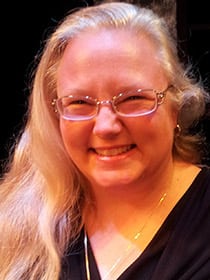
Jo Averill-Snell, lighting designer
Please explain how your lighting choices helped set the mood.
My lighting choices were driven by the text and the emotions of the scene … the author was very specific about time of day and place, so I was trying to honor and evoke that, but also basing my color choices in the mood of each scene. So for example, the English park had a colder, more grey palette than the riverside park in New Jersey. The New Jersey park had more tree gobos, so I could use that dappled light in the intimate moments where they’re sitting together. The Turkish restaurant has a top light in a deep rose that both paints the shadows in that scene in a color that feels like it might be the color of such a restaurant, and is closely related to one of the shades I use later for the tango, which is actually named Sangria. The bedroom scene is that lovely deep blue, with another gobo for the windows, and the light slowly grows brighter as we establish the scene. The transition lights in between scenes were chosen to complement Lea’s equations on the floor. I hoped that swirling pattern gave a sense of motion that worked with our textual references to the uncertainty principle.

Lea Umberger, scenic designer
Tell us about that supercool floor with the equation related to the Heisenberg principle.
It is the Heisenberg principle scaled into different sizes and spread around the space.
The overall design was a collaboration between me and Jim (Sorensen). I knew that the space needed to be defined with a floor treatment and researched the equation and did a few versions of digital sketches to play with scale, repetition and placement and worked with Jim to find a final look that we both liked.
I also worked on actually painting the floor, so creating stencils, layout, paint, with several layers of thinned-out black paint to make the letters feel like they fade in and out of the background and the whole floor almost has slightly lighter center and fades to dark as we reach the edge. The simplicity of the titles on the wall helped set the scene for each location and were taken directly from the script. Trying to mimic font and all.

… Each step in this process could not have been completed without collaboration with each of the people involved in the show, from Jim, to the actors, to Matt Cowley who helped program the title slides to the stage management team who even came in to help paint on the floor a bit to the team at HCC that helped use with space and seating set up! It is the best part of theater — working together to create a whole piece.


